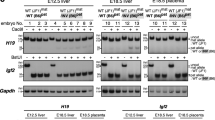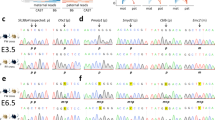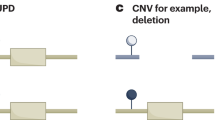Abstract
GENOMIC imprinting is a mechanism whereby only one of the two parental alleles is expressed. Loss or relaxation of genomic imprinting has been proposed as an epigenetic mechanism for oncogenesis in a variety of human tumours1–6. Although the mechanism of imprinting is unknown, differential CpG methylation of the parental alleles has been implicated7–12. The human insulin-like growth factor-II (IGF2) gene, which is transcribed from four promoters, P1–P4 (ref. 13), is imprinted in fetal liver14,15 but biallelic expression occurs in adult liver16. Like most tissues, fetal liver uses primarily promoters P3 and P4 (ref. 17). Adult liver, however, transcribes IGF2 from promoter P1, and it has been suggested that the recruitment of P1 may be responsible for the absence of imprinting in human liver, and in choroid plexus and leptomeninges18. We report here that in liver and chondrocytes, IGF2 transcripts from promoter P1 are always derived from both parental alleles, whereas transcripts from promoters P2, P3 and P4 are always from one parental allele. These findings demonstrate that imprinting and a lack of imprinting can both occur within a single gene in a single tissue, suggesting that regional imprinting factors may be important.
This is a preview of subscription content, access via your institution
Access options
Subscribe to this journal
Receive 51 print issues and online access
$199.00 per year
only $3.90 per issue
Buy this article
- Purchase on Springer Link
- Instant access to full article PDF
Prices may be subject to local taxes which are calculated during checkout
Similar content being viewed by others
References
Feinberg, A. P. Nature Genet. 4, 110–113 (1993).
Rainier, S. et al. Nature 362, 747–749 (1993).
Ogawa, O. et al. Nature 362, 749–751 (1993).
Eksberg, R., Shen, D. R., Fei, Y. L., Song, Q. L. & Squire, J. Nature Genet. 5, 143–150 (1993).
Ogawa, O. et al. Nature Genet. 5, 408–412 (1993).
Suzuki, H., Ueda, R., Takahashi, T. & Takahashi, T. Nature Genet. 6, 332–333 (1994).
Chaillet, J. R., Vogt, T. F., Beier, D. R. & Leder, P. Cell 66, 77–83 (1991).
Ferguson-Smith, A. C., Sasaki, H., Cattanach, B. M. & Surani, M. A. Nature 362, 751–755 (1993).
Li, E., Beard, C. & Jaenisch, R. Nature 366, 362–365 (1993).
Stoger, R. et al. Cell 73, 61–71 (1993).
Brandeis, M. et al. EMBO J. 12, 3669–3677 (1993).
Schneid, H. et al. J. med. Genet. 30, 353–362 (1993).
Van Dijk, M. A., Van Schaik, F. M. A., Bootsma, H. J., Holthuizen, P. & Sussenbach, J. S. Molec. cell. Endocr. 81, 81–94 (1991).
Ohlsson, R. et al. Nature Genet. 4, 94–97 (1993).
Giannoukakis, N., Deal, C., Paquette, J., Goodyer, C. G. & Polychronakos, C. Nature Genet. 4, 98–101 (1993).
Kalscheuer, V. M., Mariman, E. C., Shepins, M. T., Rehder, H. & Ropers, H. H. Nature Genet. 5, 74–78 (1993).
Sussenbach, J. S., Steenbergh, P. H. & Holthuizen, P. Growth Reg. 2, 1–9 (1992).
Ohlsson, R., Hedborg, F., Holmgren, L., Walsh, C. & Ekstrom, T. J. Development 120, 361–368 (1994).
Tadokoro, K., Fujii, H., Inoue, T. & Yamada, M. Nucleic Acids Res. 19, 6967 (1991).
Sussenbach, J. S. Prog. Growth Factor Res. 1, 33–48 (1989).
Rotwein, P. & Hall, L. J. DNA Cell Biol. 9, 725–735 (1990).
Sasaki, H. et al. Genes Dev. 6, 1843–1856 (1992).
DeChiara, T. M., Robertson, E. J. & Efstratiadis, A. Cell 64, 849–859 (1991).
Cattanach, B. M. & Beechey, C. V. Development (suppl.) 63–72 (1990).
Author information
Authors and Affiliations
Rights and permissions
About this article
Cite this article
Vu, T., Hoffman, A. Promoter-specific imprinting of the human insulin-like growth factor-II gene. Nature 371, 714–717 (1994). https://doi.org/10.1038/371714a0
Received:
Accepted:
Issue Date:
DOI: https://doi.org/10.1038/371714a0
This article is cited by
-
IGF2 deficiency promotes liver aging through mitochondrial dysfunction and upregulated CEBPB signaling in d-galactose-induced aging mice
Molecular Medicine (2023)
-
Altered gene expression of VEGF, IGFs and H19 lncRNA and epigenetic profile of H19-DMR region in endometrial tissues of women with endometriosis
Reproductive Health (2022)
-
Efficient and graded gene expression in glia and neurons of primary cerebellar cultures transduced by lentiviral vectors
Histochemistry and Cell Biology (2015)
-
Post-natal imprinting: evidence from marsupials
Heredity (2014)
-
Molekulare Progressionsmechanismen der humanen Hepatokarzinogenese
Der Pathologe (2010)
Comments
By submitting a comment you agree to abide by our Terms and Community Guidelines. If you find something abusive or that does not comply with our terms or guidelines please flag it as inappropriate.



